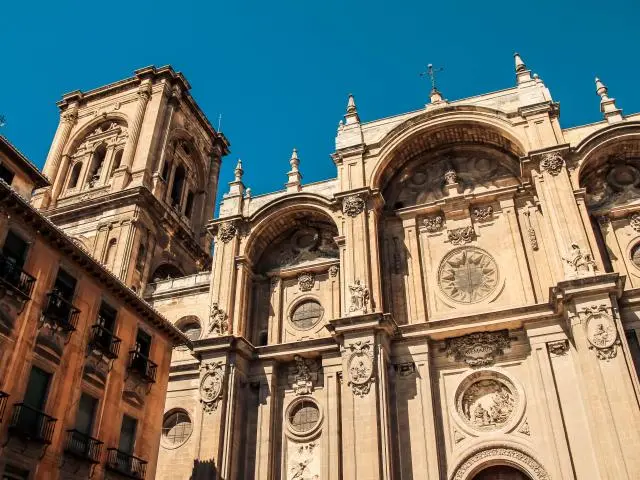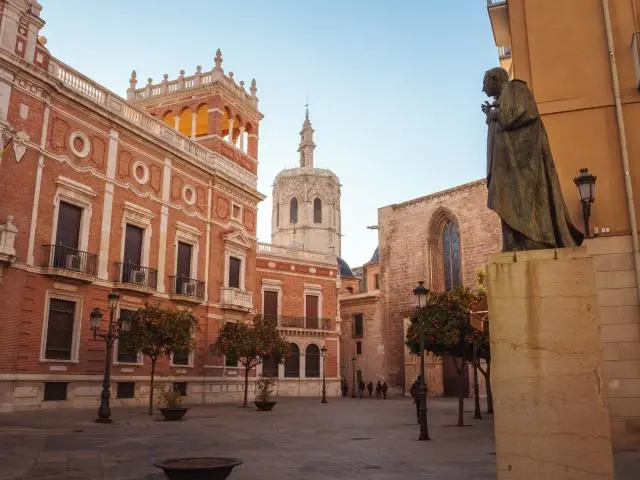Day 1 Madrid - Caceres - Seville (515 km)
Day 2 Seville
Day 3 Seville - Cordoba (119 km)
Day 4 Cordoba - Ronda - Costa del Sol (194 km)
Day 5 Costa del Sol - Granada (147 km)
Day 6 Granada - Valencia (497 km)
Day 7 Valencia - Barcelona (301 km)
Day 8 Barcelona
Day 9 Barcelona - Zaragoza - Madrid (527 km)
Day 1:
Madrid - Caceres - Seville (515 km)
Breakfast: Excluded|Lunch: Excluded|Dinner: Included
At 8:00am, we will depart from Madrid and travel to the region of Extremadura, arriving in Caceres. We will take some free time to walk around the Plaza Mayor and walk through the Old Town, a UNESCO World Heritage Site. Guests will get lunch on their own before we continue to Sevilla in the Andalusia region. We will enjoy dinner in a local restaurant before checking into our hotel for the night.
-
Caceres, SPAIN
Caceres is the capital of Caceres province, in the autonomous community of Extremadura, Spain. The municipio has a land area of 1,750.33 km2 (675.81 sq mi), the largest geographically in Spain. The walled city has been declared a UNESCO World Heritage Site.
Old Town
The Old Town of Caceres still features some of its original medieval walls. In the Middle Ages, control of the city was constantly switching between Christians and Muslims, and this struggle is exemplified by the architecture of the Old Town.
Day 2:
Seville
Breakfast: Included|Lunch: Excluded|Dinner: Excluded
We will tour Seville in the morning, visiting the Maria
Luisa Park, Plaza de Espana, the exterior of the city's
stunning Cathedral and its bell tower, called Giralda and
the typical neighbourhood of Santa Cruz with its streets,
squares and narrow alleys. If you wish, you can optionally
navigate the Guadalquivir river, during which you will enjoy
a panoramic view of the Gold Tower and Expo 92, or visit
to the Maestranza bullring. In the evening, also as an optional activity, you can attend a flamenco show.
-
Seville, SPAIN
Seville is the capital of Andalucia and the cultural and financial centre of southern Spain. A city of just over 700,000 inhabitants (1.6 million in the metropolitan area, making it Spain's 4th largest city), Seville is Andalucia's top destination, with much to offer the traveler.
Parque de Maria Luisa
On the riverbanks of Sevilla, Maria Luisa Park is a large public area that features lovely foliage, fountains, and walkways in the middle of this beautiful city. Within the park are many statues of famous Spanish figures.
Plaza de Espana
A large section of Maria Luisa Park in Sevilla, the Plaza de Espana is a large open space featuring buildings of Renaissance revival architecture. Most of the buildings are currently used for government purposes.
Seville Cathedral
The third-largest church in the world (and the largest cathedral), the Seville is a massive Gothic building. Each of its facades has multiple entrances that are all exquisitely and ornately adorned. It was built over an old mosque.
La Giralda
La Giralda was once a minaret for the Muslim population in medieval Sevilla, but was converted to a church bell tower after Christian forces had regained power in Iberia. Its design has influenced many other towers around the world.
Santa Cruz (Jewish Quarter)
The barrio of Santa Cruz in Sevilla was once the city's Jewish Quarter, and is now the most popular tourist are in the city. The narrow, winding streets and alleyways of this neighborhood remind visitors of a labyrinth.

Sevillian Night in Patio Sevilla
One of the most famous and well-known tablaos in Sevilla. You will get to know the Andalusian art that is captured in the dance, the guitar playing and the cante in the show. Dancers and singers with national and international awards will show us the art of flamenco and Spanish classical dance.
Tour Fee (Optional): Adult $46 / €40; Child $46 / €40; drink included|Duration: Approx. 1 Hour 30 Minutes
Day 3:
Seville - Cordoba (119 km)
Breakfast: Included|Lunch: Excluded|Dinner: Included
In the morning, we will head to Cordoba, visiting the Mosque-Cathedral, the Jewish Quarter, and more. Then, we will have the rest of the day free to spend at our own leisure.
-
Cordoba, SPAIN
Cordoba is a city in Andalusia, Spain, and the capital of the province of Cordoba. The city is located on the banks of the Guadalquivir river, and its easy access to the mining resources of the Sierra Morena satisfies the population's needs.
The Mosque-Cathedral of Cordoba
The interior of this dual mosque-cathedral perfectly reflects the religious power-struggle of medieval Spain. The conversion of the church into a mosque lasted from 784 to 987. The complex is massive and features many small chapels.
Jewish Quarter
Cordoba's Jewish Quarter is marked by narrow and irregular streets. It houses a medieval Synagogue and the Sephardic House. Unfortunately, this neighborhood was a focal point of the Spanish Inquisition, during which Cordoba played a large role.
Day 4:
Cordoba - Ronda - Costa del Sol (194 km)
Breakfast: Included|Lunch: Excluded|Dinner: Included
On our way to Costa del Sol, we will stop in the village of Ronda to see the famous Puento Nuevo Bridge. After some free time here, we will continue to the Costa del Sol, where we will eat dinner and spend the night.
-
Ronda, SPAIN
Ronda is a city in the Spanish province of Malaga. It is located about 100 kilometres (62 mi) west of the city of Malaga, within the autonomous community of Andalusia.
Puente Nuevo Bridge
This 18th century bridge crosses a 390-foot deep ravine that divides the small Andalusian city of Ronda. There is a central chamber underneath the bridge's walkway that today houses a small exhibit about the bridge's history.
-
Costa del Sol, SPAIN
It is a region in the south of Spain, in the autonomous community of Andalusia, comprising the coastal towns and communities along the coastline of the Province of Malaga. Formerly made up only of a series of small fishing settlements, today the region is a world-renowned tourist destination.
Day 5:
Costa del Sol - Granada (147 km)
Breakfast: Included|Lunch: Excluded|Dinner: Included
After breakfast, we will drive to Granada, where we will visit the Alhambra, the massive fortress complex built by the former Arab rulers of southern Spain. We may also take an optional trip to the Caves of Sacramonte and see a special flamenco show.
-
Granada, SPAIN
Granada is a mid-sized provincial capital in the Andalucia region of Spain. Rich in history and culture, Granada is arguably the single most worthwhile city in Spain for visitors. Spring and autumn are also both excellent times to visit.
Alhambra
The Alhambra is a massive complex consisting of multiple palaces and fortresses. It originated as a Spanish-Muslim fortress in the 9th century, but subsequent rulers, both Muslim and Christian, continually added additions and renovations.
Caves of Sacromonte
The soft rocks on the hillsides in the Granada neighborhood of Sacromonte were carved into cave-dwellings by the nomadic Gitano people in the area in the 19th century, many of whom still inhabit these caves.
Day 6:
Granada - Valencia (497 km)
Breakfast: Included|Lunch: Excluded|Dinner: Excluded
After breakfast, we will depart for Valencia, passing many beautiful palaces in the Spanish countryside on the way. Upon our arrival in Valencia, we will have the rest of the day to explore the city.
-
Valencia, SPAIN
Valencia is the capital of the autonomous community of Valencia and the third largest city in Spain after Madrid and Barcelona. The Port of Valencia is the 5th busiest container port in Europe and busiest container port on the Mediterranean Sea.
Day 7:
Valencia - Barcelona (301 km)
Breakfast: Included|Lunch: Excluded|Dinner: Excluded
In the morning, we will eat breakfast, then depart for Catalonia, where we will reach the sprawling city of Barcelona, where we will have the remainder of the day to explore.
-
Barcelona, SPAIN
This gorgeous Spanish city on the Mediterranean is one of the world's most popular tourists destinations due to its rich cultural heritage. Visitors can see medieval buildings or admire modernity at the Museum of Contemporary Art.
Day 8:
Barcelona
Breakfast: Included|Lunch: Excluded|Dinner: Excluded
After a delightful breakfast, we will embark on a sightseeing tour of Barcelona, viewing the large park atop Montjuic Hill, the Anella Olimpica, the Columbus Statue, and the old Gothic Quarter. We will then have the afternoon at our leisure.
-
Barcelona, SPAIN
This gorgeous Spanish city on the Mediterranean is one of the world's most popular tourists destinations due to its rich cultural heritage. Visitors can see medieval buildings or admire modernity at the Museum of Contemporary Art.
Montjuic Hill
Rising above the Barcelona's harbor is Montjuic Hill. Parks and gardens rest on this hill, converging with each other via winding paths carved into the hillside, along with a Greek amphitheater, various museums and the Olympic Park.
Anella Olimpica
Barcelona's Anella Olimpica, the series of athletic facilities in the park atop Montjuic hill, was the site of the 1992 Summer Olympics. The complex was designed in a contemporary minimalist style, and the individual facilities are connected by a plaza.
Columbus Monument
Christopher Columbus is immortalized with a towering monument on Barcelona's famous walkway, La Rambla, depicting the famed explorer pointing out towards the sea. Visitors can take an elevator to the top, which offers a thrilling view of the city.
Gothic Quarter
Barcelona's Gothic Quarter was once the city's center in medieval times, and many of the buildings date to this period, some even earlier to when the city was merely a Roman settlement.
Day 9:
Barcelona - Zaragoza - Madrid (527 km)
Breakfast: Included|Lunch: Excluded|Dinner: Excluded
After breakfast, we will depart Barcelona through Lerida and Zaragoza. Afterward, we will return to Madrid to end the tour.
If in any case, The Patronato of The Alhambra and Generalife were not granted tickets for certain dates for the participants of the Visit, a tour of the city of Granada will be provided instead: Visit to the Palace of Carlos V, the Archaeological Museum, Church of Santa Maria de la Alhambra, Royal Chapel and a walk through the city Alcaiceria (silk market) and the Cathedral Square.







 7-Day Andalusia and Barcelona Tour from Madrid...
7-Day Andalusia and Barcelona Tour from Madrid...
 8-Day Andalusia & Costa del Sol Tour from Madrid...
8-Day Andalusia & Costa del Sol Tour from Madrid...
 9-Day Portugal & Andalusia Tour from Madrid...
9-Day Portugal & Andalusia Tour from Madrid...
 10-Day Andalusia & Morocco Tour from Madrid...
10-Day Andalusia & Morocco Tour from Madrid...
 7-Day Spain and Portugal Europe Tour to Madrid, Barcelona, Ali...
7-Day Spain and Portugal Europe Tour to Madrid, Barcelona, Ali...